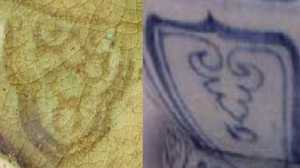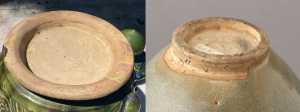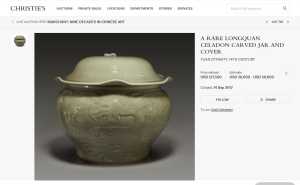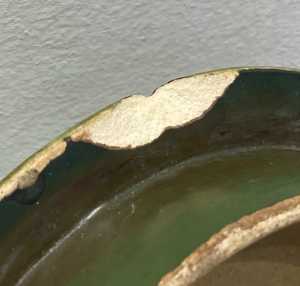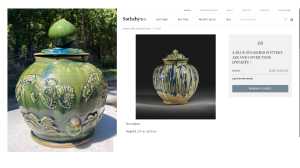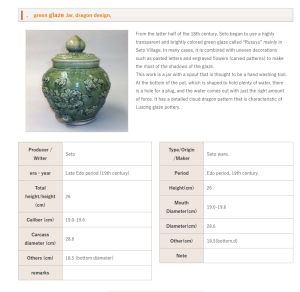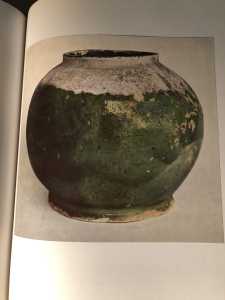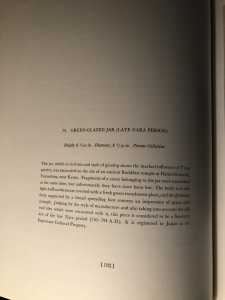The Chinese and Asian Art Forum. For Fans, Collectors and Dealers.
 Basic Rules For the BidAmount Asian Art Forum: Talk about whatever you want. You can even discuss and offer things that are for sale if they are authentic. Maximum image file size per post is 2 MB. Images of 700pxl x 700pxl are optimal if saved at a medium resolution. Be respectful of others and enjoy yourself. Click the YouTube link for a brief tutorial on using the forum. You can also EMBED Videos by cutting and pasting from You-Tube, Vimeo etc.
Basic Rules For the BidAmount Asian Art Forum: Talk about whatever you want. You can even discuss and offer things that are for sale if they are authentic. Maximum image file size per post is 2 MB. Images of 700pxl x 700pxl are optimal if saved at a medium resolution. Be respectful of others and enjoy yourself. Click the YouTube link for a brief tutorial on using the forum. You can also EMBED Videos by cutting and pasting from You-Tube, Vimeo etc.
NOTE: To post an item or add a new post, click open the category title from the FORUM LIST, and CLICK the Blue ADD TOPIC button.
@greeno107 Thank you for the interesting thread, which I am enjoying following. I am still stumped by it having had a spout but no handle, (wine jar?), and it has similarities and differences to all the types members have suggested. Just looking at the examples, it looks more like the open two handled incense burner to me, but Brian's idea about the jun glaze being used as a repair material in the one photo shot seems logical, as it seems to flow into a loss. You found a good mystery, did you find others at the sale?
@sharonp This jar/jug is a real puzzle.
I'm not aware that glaze was used as a means to repair damage, but the glaze appears on the body, too, where there is no damage. From what I have pieced together, celadon and jun glaze is very similar. In fact, there are green jun wares (they're rare). However, the overall glaze does not share much simiilarity with the opaque and rather thick jun glaze, except in the area on the cover, and a few spots throughtout the body.
I'm making a big stretch to try and provide an explination, and without a comparative I'm probably wrong, but at the end of the Yuan/start of the Ming, celadon ware's popularity started to slow down... blue and white wares became dominant. I think it might be possible that kilns were using up the glaze that they had left, before switching to blue and white production. So, maybe a kiln had a little jun glaze left over, and splashed the longquan glaze as an artistic effect? Crazy, right?
The estate sale was at a nice waterfront property, probably in the $800k- $1million price point. The location of the sale is one that I have first hand knowledge that many well known collectors live (or have lived). In fact, there is a very famous collection (or what remains of it) that I've been waiting on for a few years, now.
I bought most of the Asian items - 18th c. arita/kakiemon bowl, Pr. coral ground jars w/ Qianlong marks (Republic period), Kangxi bisquit fanghu vase w/ green sancai glaze, and Kangxi guanyin biscuit figure with sancai glaze.
I did not buy a small 18th c. Dehua boy w/ flute on water buffalo figure (too small for my taste), a green monochrome vase with ruyi handles that was lamped ($500)... labled as 18th c., but likely 19th c, and a pair of small Qianlong period export covered bowls with very beautiful animal form handles - too expensive for my taste (the old label had a price of $10,500 and looked to be from around 1980, and the seller was asking $2,500).
The house also had a very large collection of sterling silver and a good selection of period furniture.
I think I've reached my limit on what I can research - If you have any additional info, please post.
I'm of the opinion that the jar is late Yuan to early Ming.
The design contains elements that are strongly Yuan, such as the overall form (guan shaped jar), the lappets, and the extremely wide/deep foot rim, and other characteristics that reflect more Ming.
These photos are comparisons with known Yuan pieces:
The central design of the dragon over water design is also known in the Yuan, but rocks are absent, so perhaps the appearance of rocks occurs in the Ming.
Also, the paste does seem to match up well with Yuan jun wares and Ming longquan wares, which apparently had low iron.
Take a look at this chip on the inside of the cover... this looks like recent damage.
The paste is WHITE and a bit granular/chaulky. I don't think this is earthenware, but I'm not certain.
The celadon glaze does seem to share some characteristics of the dripping/thinning application of Yuan (and earlier) Yaozhao wares, and as William pointed out, in the Ming, there are bluish green glazed earthenware that also share that manner of application.
The large finial and spout remains a complete mystery, and possibley suggests a completely different line of origin (perhaps Japanese or South East Asian).
So, I'm out of ideas. Help.
@ming1449 Hey Stuart! I'm not sure how I missed your post. Thank you so much. The Japanese esthetic certainly is prevalent in the design.
Do you have any thoughts on why there is an application of the 'jun' blue to the jar? Any thoughts on the function of the jar with such a small spout located very low on the body?
Kindly,
Tim
@ming1449 Stuart..
I haven't considered older periods, but looking at this blue splashed jar from the Tang dynasty, the form and cover (with smaller finial) sure has some similarities. But, the paste used in my jar is not Tang like (I don't think).
You don't think it could be older than Yuan, do you?
Hey Tim,
Awesome jar!
It is Japanese and Seto ware, from the late Edo period, I'd say anywhere from the mid 18th to first few decades of the 19th centuries. That Jun effect you see is often seen on other Seto wares and Oribe type wares too.
Here is an example from the Aichi Prefecture museum. Ill include the link below.
Cheers,
Jeremy
https://www.pref.aichi.jp/touji/collection/08/collection/08.html
I wanted to add that while these green glazed pieces are somewhat common, I don't recall seeing a jar with its lid for sale.... only in museums.
You can plug this into google and perhaps track down more info, but likely you will only find jardinieres and smaller pieces. ( るすゆう 瀬戸 ) or ( 呂宋 瀬戸 )
Here is a preview for a Seto exhibition and in the background you can see another, or perhaps it is the same one...
http://seto-cul.jp/information/index.php?s=1327903003
Thanks! It was one of those " I know I have seen one of these before.... but where???" moments. Glad I could think of it.
@jbeer2121 Wow! Nice find, Jeremy, thank you!
A rather nice looking water jug used for washing hands... very neat!
This is a great example of how how cultures borrow from each other, that they can appear quite ancient. And, conversely, how ancient pieces can retain their youthfulness, and appear so much like more recent versions.
The finial had broken off the lid some time ago, but appears to have been re-attached rather recently with a glue gun (and poorly I might add).
And so, thank you again, since I'm using your 'cooking' technique - came right apart, and with some minor scraping, I'm down to the original porcelain and I'm re-gluing with water-soluable glue.
I'm leaving the other condition issues be, including the lacquer/wax plug that is in the spout.
Looks like I can 'wash my hands' of this mystery.
As with William and Tim, a great comparison and an excellent example of how later Japanese kilns/potters were inspired by and based upon there pieces on earlier Chinese motifs/forms and glaze types ...
Stuart
@jbeer2121 Yes, thank you Jeremy, most excellent sleuthing. That was a fun thread.
Stuart, Tim,
It is interesting to see you both mention the mimicking of the Chinese wares of older eras.... I thought I'd share my thoughts on the basis of this particular green glaze in Seto.
While researching that Seto flask I posted a while back I came to realize that during the late Edo period the kilns were producing wares as an homage to the earlier " Master" wares, or historically important eras. The drippy ash glazes are a good example, such as my flask which has a Korean form and very much resembles Kamakura Period Seto flasks( I must admit, having shown it to a number of specialists and curators and I don't think I will ever know if it is 12-13th century or 18th/19th), and the methods used were so good they are nearly impossible to tell apart. It seems it was always considered that this green glazed Seto from the late Edo period is copying the Nara green glazed wares (I'll post an example from one of my books), which for a long time were thought to be copying Tang copper and lead green glazed wares. The funny thing about this is that the Nara and Tang periods overlap so very closely, and the Tang globular jars as Tim posted above, clearly also show this squat form.... A thought that I've been tumbling around in my head is why most early early Japanese( I mean like 1500 BC) jars are also squat and globular, long before the Chinese were styling theirs like that, and it has continued to this day especially in tea wares, like Chaire ( tea caddies), so is this a Japanese form, and a Chinese glaze, or were there cultural overlaps, even 3000 years ago or more.... a fun puzzle.
It is just another one of those, which came first the Chicken or the egg?
Cheers,
Jeremy
Sorry these are so dark...
@jbeer2121 thanks for doing that. I was following along.
Its a wild ride isn't it....digging into the the dusty corners of one's brain to find that thing you swear you recall seeing.... haha.
Jeremy
Thanks for visiting "The BidAmount Asian Art Forum | Chinese Art"
If you sell on eBay, or have a shop feel free to post images and descriptions and links.
Check back often for discussion about the latest news in the Chinese art and antique world. Also find out about the latest Asian art auctions at Sotheby's, Christie's, Bonhams and Tajans.
Auction results for: fine porcelain, ceramics, bronze, jade, textiles and scholar's objects. As well as Japanese, Thai, Vietnamese and other Asian cultures.
Thank you,
Peter Combs
Topics and categories on The BidAmount Asian Art Forum | Chinese Art
Kangxi vases, Kangxi dishes and chargers, Kangxi ritual pieces, Kangxi scholar's objects, Qianlong famille rose, Qianlong enamels, Qianlong period paintings, Qianlong Emporer's court, Fine porcelain of the Yongzheng period. Chinese imperial art, Ming porcelain including Jiajing, Wanli, Xuande, Chenghua as well as Ming jades and bronzes.
The BidAmount Asian Art Forum | Chinese Art
A free Asian art discussion board and Asian art message board for dealers and collectors of art and antiques from China, Japan, Korea, Thailand, Cambodia, Vietnam and the rest of Asia. Linked to all of the BidAmount Asian art reference areas, with videos from plcombs Asian Art and Bidamount on YouTube. Sign up also for the weekly BidAmount newsletter and catalogs of active eBay listing of Chinese porcelain, bronze, jades, robes, and paintings.
The art of calligraphy - and for the ancient Chinese it certainly was an art - aimed to demonstrate superior control and skill using brush and ink. Calligraphy established itself as one of the major Chinese art forms during the Han dynasty (206 BCE - 220 CE), and for two millennia after, all educated men were expected to be proficient at it.
The Museum’s collections of Asian art span nearly five millennia and encompass the cultures of China, the Himalayas, India, Japan, Korea, and Southeast Asia. In 2007, the Museum launched an initiative to create dedicated galleries for the collection, beginning with a gallery for the arts of Korea ...
Chinese art is full of symbolism, in that artists typically seek to depict some aspect of a totality of which they are intuitively aware.
China Online Museum is the finest online museum of Chinese art. It features Chinese calligraphy, painting, ceramics, bronzes, carving, and other artworks.
Chinese Ceramics & Works of Art. Overview Upcoming auctions Contacts Auction results ... Christie’s sales of Chinese ceramics and works of art showcase centuries of Chinese history. Held throughout the year in London, New York, Paris and Hong Kong, they attract a wide audience of collectors and connoisseurs vying for pieces as diverse as ...
Explore Asian Art Week. Contact the Specialist Department. Chinese Paintings ... Senior Specialist, Head of Sale. [email protected]. Tel:+1 212 641 5760. Bid in-person or online for the upcoming auction:Fine Chinese Paintings on 10 September 2019 at New York. Bid in-person or online for the upcoming auction:Fine Chinese Paintings on 10 ...
Discover an abundance of must-see art from all corners of a vast continent at Christie’s NY Asian Art Week. From contemporary classical and Chinese paintings to works with exemplary provenance from the Art Institute of Chicago, our Rockefeller Paza galleries will be full of ancient treasures and contemporary masterworks in a salute to the vibrant arts of Asia.
Sold to benefit The Art Institute of Chicago’s Asian Art Acquisition Fund, the sale features 84 lots with a focus on Ming and Qing porcelains, and offers a rare insight into the taste for collecting Chinese ceramics and works of art in the Midwest from the end of the 19th century through the 1980s. Highlights include two Wanli wucai garlic-head vases, a Qianlong mark and period, blue and ...
Specialist, Chinese Paintings, Christie's London Dr Malcolm McNeill is a Specialist in Chinese Paintings at Christie’s, based in London. He previously worked as an assistant curator of the Chinese collections and the Victoria and Albert Museum in London, as a researcher at the British Museum, and as a translator and tour guide at the National Palace Museum in Taipei.
The Christie's Education 2020 Conference: The Chinese Art Market 18 Jun 2019 Christie’s Education is delighted to announce our first international academic conference in Asia which will take place in Hong Kong from 26-27 November 2020 at the Hong Kong Convention and Exhibition Centre and will run in parallel with Christie’s Hong Kong Autumn Auctions.
The summer Chinese Art sale in Hong Kong will feature works of art from several private collections, including Qing porcelains and textile from the collection of the legendary Chinese art dealer A. W. Bahr (1877–1959), fine gilt bronze Buddhist sculptures from an old Hong Kong collection, an East Asian collection of Qing dynasty wine cups and jades, and a Japanese collection of Song ceramics ...
Sotheby's Chinese Works of Art Department holds two auctions each year in London, New York, Hong Kong and Paris.
Chinese Art - View Auction details, bid, buy and collect the various artworks at Sothebys Art Auction House.
With more than 340 Chinese works of art dating from the Neolithic to the Republic periods, highlights of this sale include a selection of Qing Imperial monochromes from the collection of Arnold and Blema Steinberg, early ceramics from the Art Institute of Chicago and Chinese porcelain and works of art from the collection of Henry Arnhold.
Results: Sotheby's Asia Week achieved $52.4 million in six strong auctions, exceeding pre-sale estimates. With 76.5% of lots sold and 60.3% of lots surpassing high estimates, the Asian art sales at Sotheby's indicate continued collector interest in the finest works of art from China, India and and the Himalayas.
Today's sale of Important Chinese Art will proceed as planned with sessions at 10 AM and 2 PM EDT. Sotheby's will be monitoring the weather conditions throughout the day and will be available to coordinate alternative bidding options should conditions make it difficult for clients to attend the auction in person.
Bonhams Chinese Art department is renowned for offering the finest works of art representing the richness and breadth of China's artistic heritage, particularly Imperial porcelain, white and spinach green jades, cloisonné and Buddhist art. Specialised international auctions are held globally, including London, Hong Kong and San Francisco.
Bonhams : Chinese Works of Art We use cookies to remember choices you make on functionality and personal features to enhance your experience to our site. By continuing to use our site you consent to the use of cookies. Please refer to our privacy and cookie policies for more information.
Bonhams Fine Art Auctioneers & Valuers: auctioneers of art, pictures, collectables and motor cars. We use cookies to remember choices you make on functionality and personal features to enhance your experience to our site. By continuing to use our site you consent to the use of cookies. ... Chinese Art (US) General enquiries
Bonhams : Fine Chinese Art We use cookies to remember choices you make on functionality and personal features to enhance your experience to our site. By continuing to use our site you consent to the use of cookies. Please refer to our privacy and cookie policies for more information.
Bonhams Fine Art Auctioneers & Valuers: auctioneers of art, pictures, collectables and motor cars Bonhams : Asian Art We use cookies to remember choices you make on functionality and personal features to enhance your experience to our site.
Bonhams are international auctioneers of fine Chinese and Japanese art. We specialise in rare Imperial and Export Chinese ceramics and works of art, as well as Japanese ceramics, fine and decorative works of art from the Neolithic Period to the 20th century. View on map
Bonhams Fine Art Auctioneers & Valuers: auctioneers of art, pictures, collectables and motor cars. We use cookies to remember choices you make on functionality and personal features to enhance your experience to our site. By continuing to use our site you consent to the use of cookies. ... Asian Art Bonhams. Work. 22 Queen St.
